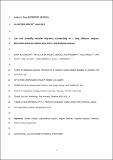Low and annually variable migratory connectivity in a long distance migrant : Whinchats Saxicola rubetra may show a bet-hedging strategy
Abstract
The spatial scale of non-breeding areas used by long distance migrant animals can vary from specific, relatively small non-breeding areas for each independent breeding population (high connectivity) to a distribution over a large non-breeding area with mixing of breeding populations (low connectivity). Measuring variation in the degree of connectivity and how it arises is crucial to predict how migratory animals can respond to global habitat and climate change because low connectivity is likely an adaptation to environmental uncertainty. Here, we test whether use of non-breeding areas in a long distance migrant may be stochastic by measuring the degree of connectivity, and whether it is annually variable. 29 wintering Whinchats tagged with geolocators over two years within 40 km2 in central Nigeria were found breeding over 2.549 million km2 (26% of the land area of Europe), without an asymptote being approached in the relationship between area and sample size. Ranges differed in size between years by 1.506 million km2 and only 15% of the total breeding range across both years overlapped (8% overlap between years when only first year birds were considered), well above the range size difference and below the proportion of overlap that would be predicted from two equivalent groups breeding at random locations within the observed range. Mean distance between breeding locations (i.e. migratory spread) differed significantly between years (2013, 604 ± 18 km; 2014, 869 ± 33 km). The results showed very low and variable connectivity that was reasonably robust to the errors and assumptions inherent in the use of geolocators, but with the caveat of only two years’ ranges to compare, and the sensitivity of range to the breeding locations of a small number of individuals. However, if representative, the results suggest the scope for between-year variation (cohort effects) to determine migrant distribution on a large scale. Furthermore, for species with similar low connectivity, we would predict breeding population trends to reflect average conditions across large non-breeding areas: thus, as large areas of Africa become subject to habitat loss, migrant populations throughout Europe will decline.
Citation
Blackburn , E , Burgess , M , Freeman , B , Risely , A , Izang , A , Ivande , S , Hewson , C & Cresswell , W 2017 , ' Low and annually variable migratory connectivity in a long distance migrant : Whinchats Saxicola rubetra may show a bet-hedging strategy ' , Ibis , vol. 159 , no. 4 , pp. 902-918 . https://doi.org/10.1111/ibi.12509
Publication
Ibis
Status
Peer reviewed
ISSN
0019-1019Type
Journal article
Description
This work was supported by the Chris Goodwin, A.P. Leventis Conservation Foundation, A.P. Leventis Ornithological Research Institute, the British Ornithologists' Union and the Linnean Society.Collections
Items in the St Andrews Research Repository are protected by copyright, with all rights reserved, unless otherwise indicated.

